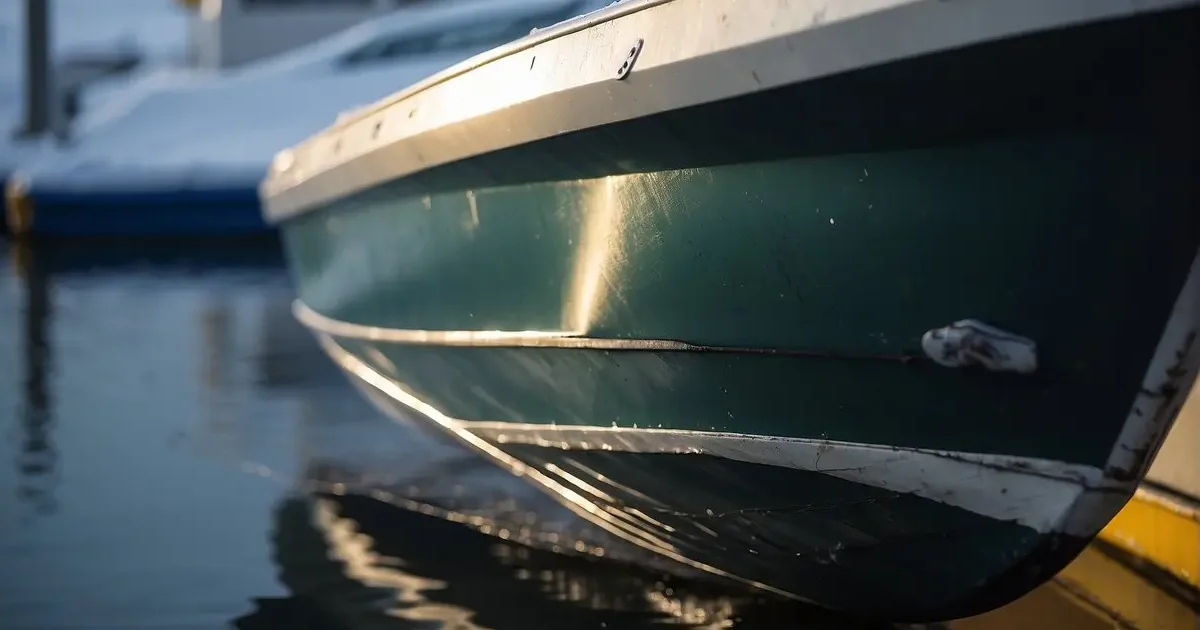Winterize a boat efficiently and effectively with this simple 10-step guide. As temperatures drop, safeguarding your boat from the harsh elements is essential. My Article will offer the ultimate solution to prepare your vessel for off-season care, ensuring it emerges unscathed and ready for spring.
Avoid costly repairs and embrace peace of mind; let’s get your boat winter-ready. In This article I’ll show you how to winterize a boat quickly, ensuring it’s safe until spring in ten easy Steps!
How To Winterize a Boat in 10 Easy Steps
Preparing to winterize a boat ensures it remains in top condition for the next season. As I start the process, I’m careful to focus on protecting the engine and other critical components from the harsh winter elements.
- Drain Water: Empty all engine, tank, and plumbing water.
- Add Fuel Stabilizer: Treat the fuel with a stabilizer to protect the engine.
- Change Engine Oil: Remove old oil, which can contain damaging acids.
- Disconnect Battery: Prevent power drain and preserve battery life.
- Fog the Engine: Apply fogging oil to the engine to protect internal parts.
- Grease Moving Parts: Lubricate steering systems and control mechanisms.
- Clean and Dry: Thoroughly ensure everything is dry to prevent mold.
- Cover It Up: Secure a breathable cover to safeguard the boat from the weather.
- Antifreeze: Add antifreeze to the plumbing to avoid freezing damage.
- Inspect and Repair: Use this time to inspect and make necessary repairs.
Taking these steps helps me ensure that my boat stays in excellent condition through winter and is ready to go when warmer days return.
Preparing Your Boat for Winterization

When I winterize a boat, I make sure it’s clean, protected, and ready to face the cold. It’s a crucial step to prevent costly damage and ensure a smooth sailing season ahead.
Cleaning and Storage
Clean: My first step is to give the boat a thorough cleaning. I remove any debris, wash the deck and hull meticulously, and ensure the interior is spotless. Dirt and grime can cause corrosion and other damage, so I make sure it’s as clean as possible before Storage.
- Deck & Hull: Scrub and rinse thoroughly.
- Interior: Vacuum and wipe down all surfaces.
Dry Storage: I always opt for dry Storage to prevent the hull from freezing and cracking. Letting the boat dry thoroughly is essential to avoid mold and mildew formation.
- Lift for dry Storage: yes or no
- Time to dry before storing: 24-48 hours
Protecting the Exterior
Wax: Once clean, I apply a generous coat of marine-grade wax to shield the exterior, which helps protect against moisture and UV damage during the winter months.
- Wax Type: Marine-grade paste or liquid wax
- Coverage: Entire hull and topsides
Cover: A robust cover is non-negotiable. Whether I use a custom-fit cover or get the boat shrink-wrapped, it must be appropriately secured to keep out pests and precipitation.
- Cover Type: Fitted canvas or shrink-wrap
- Securing Method: Straps or weights
By tackling these specifics during winterization, I set myself up for a worry-free off-season and a swift return to the water come spring.
Winterizing the Engine and Fuel System

When I winterize a boat, the engine and fuel system are where I focus a lot on ensuring everything is ready for the cold months ahead.
Fuel System Maintenance
The first step in maintaining the fuel system is to fill the fuel tanks to minimize condensation and add a fuel stabilizer to prevent the fuel from deteriorating. It’s also essential to change the fuel/water separator and filters to keep the engine clean from any potential debris or water that could have entered the system during regular use.
Engine and Oil Care
Caring for the engine involves changing the engine oil and oil filter to eliminate any contaminants that can cause corrosion over time. I suggest using fogging oil within the engine block and cylinders to protect the internal parts from rust. Whether you have an outboard motor, inboard motor, or stern drives, it’s essential to flush the engine with non-toxic antifreeze to prevent freeze damage and lubricate the engine’s inner workings effectively.
Protecting Boat Systems from Freezing

When winterizing a boat, I always aim to shield the vital systems from the harsh effects of freezing temperatures. Properly preparing for winter involves meticulous attention to freshwater systems and the bilges to prevent freeze damage.
Freshwater Systems Care
The freshwater systems on my boat are especially vulnerable as temperatures drop. To prevent damage, I ensure all water is drained from the pipes, water heater, and tanks. This is crucial because when water freezes, it expands, causing pipes to burst and leading to costly repairs.
Once the systems are drained, I add non-toxic antifreeze to protect the system. The non-toxic variety is significant because it’s safe for the environment and will be present in systems I use for drinking water come spring.
- Drain: All freshwater tanks, water heater, and pipes.
- Add Non-toxic antifreeze to each drained system.
Sanitation and Bilge Considerations
In dealing with sanitation, the holding tanks require attention. I drain the holding tank entirely and add non-toxic antifreeze here, too. This prevents sewage from freezing, which could lead to a messy and expensive situation.
The bilges and bilge pump are checked for any water that might be lurking. I dry the bilges thoroughly and ensure the bilge pump is debris-free. A frozen bilge pump can be a real headache, as it’s responsible for pumping out any water that might enter the boat – if it’s out of action due to ice, I could be in trouble.
- Holding Tanks: Drain and replace with non-toxic antifreeze.
- Bilges: Dry entirely and check the bilge pump for obstructions.
Electrical System and Battery Maintenance

As I prepare to winterize a boat, I know that taking care of the electrical system and the battery is crucial for ensuring everything is in top shape come spring. Dealing with the bitter cold can be harsh on marine batteries and electronics, so here’s my approach to maintaining them.
Battery Care:
- Charge: First, I make sure my battery is fully charged; this is essential to prevent it from freezing.
- Disconnect: I then disconnect the battery to halt any possible electrical draw.
- Storage: I store my battery in a location that avoids extreme temperatures; guidance from Don’t Let Cold Winter Temperatures Ruin Your Batteries suggests a dry place between -10 and 140 degrees Fahrenheit.
| Do’s | Dont’s |
| Check battery charge monthly | Leave the battery connected and unattended |
| Clean the battery terminals to prevent corrosion | Expose the battery to extreme temperatures |
Electronics:
- Consult Manual: I always refer to my owner’s manual for electronic devices to ensure I follow manufacturer-specific recommendations.
- Corrosion Prevention: I inspect all connections and apply a corrosion inhibitor to prevent corrosion.
- Remove Devices: If possible, I remove sensitive electronics and store them safely indoors.
It’s essential to work safely while handling battery and electronic system maintenance, taking care to isolate electric sources, and following all safety precautions properly. Remember to inspect your boat’s electrical wiring for any signs of wear or damage, and consider having a professional look over your system if you need clarification on any aspect of this process.
With these steps, I can rest easy knowing I’ve done my best to protect my boat’s electrical system through the chillier months.
FAQ – How To Winterize a Boat

As a boat owner, I know how crucial it is to properly winterize a boat to protect it from the cold and elements. Let’s go through some common questions to ensure your vessel stays in top shape for spring.
How do you properly winterize a boat?
To properly winterize a boat, I follow these steps: First, I add a fuel stabilizer to the tank and run the engine to distribute it. Then, I change the oil and filters to prevent corrosion. All water must be drained from the engine, and antifreeze should be added to the cooling system.
I also make sure to protect the engine by applying fogging oil. For inboard engines, draining the coolant and replacing it with non-toxic antifreeze is essential. The batteries are removed and stored after being fully charged. I don’t forget to clean and dry the boat before covering it up to prevent mold and mildew.
Is winterizing a boat hard?
The difficulty of winterize a boat can vary depending on the boat’s size and type. It’s not particularly hard, just a bit time-consuming. It’s about being thorough with each step, such as hooking up “ear muffs” to the engine and running it to apply fogging oil or ensuring all plumbing systems have been treated with non-toxic antifreeze.
It can seem daunting for first-timers, but with a good checklist and careful attention to detail, it’s manageable.
Should I take my boat out of the water in winter?
Taking your boat out of the water in winter is often recommended, and I prefer to do so. By winterizing a boat, you can maintain all systems properly without the risk of ice damage, making it easier to cover and store.
However, if necessary, boats can remain in the water if they are adequately prepared and monitored throughout the season, such as using bubblers around the hull to prevent ice formation.
Drop anchor in the discussion! Contribute your insights and stories about winterizing your boat below, and aid your fellow seafarers in navigating the chilly months ahead.











